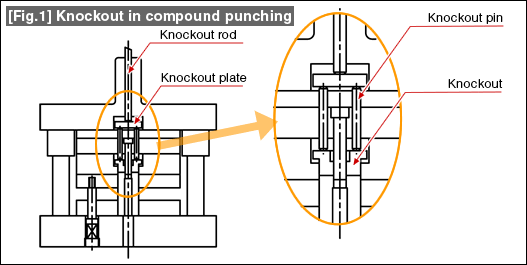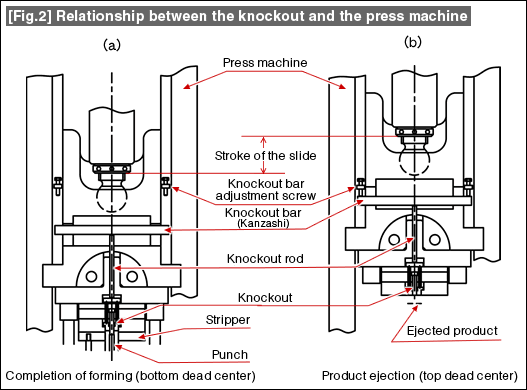#154 Design of Compound Punching Dies (3) Taking out a Product in Compound Punching (Knockout)
The die structure in compound punching is shown in Fig. 1. This is a structure in which the die for outer shape punching (blanking) is in the top die. This type of a structure is called an "inverted placement structure". In the inverted placement structure, the product after outer shape punching enters the die in the top die. Since the top die is attached to the slide of the press machine and carries out up and down movement, if the product that has entered the die is not ejected well, it can lead to breaking of the die. The die component for ejecting the product that has entered into the die is called a knockout. This is a characteristic component of the inverted placement structure. Although the inverted placement structure is used quite often for drawing other than punching operations, the work of the knockout is the same.

(1) Knockout structure of the die
Recently, the action of taking out a product from the die is very often called as "ejecting". However, this action is frequently called "knocking out" in press forming operations. Either way is acceptable. However, the die component used for this action is called a "knockout". The structure of a knockout is explained using Fig. 1. The knockout is present inside the die. The knockout is prepared in almost the same shape as the die. A flange, etc., is provided to prevent it from falling off. When the outer shape is punched from the material, the knockout is pushed up along with the removed material. Near the top dead center, the knockout is pushed from behind, and returns to the shape before carrying out the outer shape punching, thereby ejecting the product. The components pushing the knockout from behind are the knockout pin, knockout plate, and knockout rod. Depending on the structure of the die, sometimes the structure is such that the knockout is pushed directly by the knockout rod. The press machine applies force to the knockout rod.
(2) Relationship between the knockout and the press machine
See Fig. 2. The components of the press machine related to the knockout are the "knockout bar" and the "knockout bar adjustment screw or rod". The field term for this part is ornamental hair pin, or "Kanzashi". Field terms are used in order to avoid the confusion between words such as knockout bar and knockout rod, etc. The knockout that has been pushed up after the outer shape punching has been completed, pushes up the Kanzashi via the knockout rod (Fig. 2(a)). This position is the bottom dead center of the slide of the press machine. The slide rises with the knockout in the pushed up state. Near the top dead center, the Kanzashi butts against the knockout bar adjustment screw and carries out the operation of returning the pushed up Kanzashi to its original position, hence the product is ejected (Fig. 2(b)). The adjustment of the "knockout bar adjustment screw" is something that requires care to be exercised during the operation of the knockout. Near the bottom dead center, if it contacts the Kanzashi too soon, the pushing down length of the knockout becomes too long which can lead to breakage of the die or the knockout. In the case of a top die fixed to the shank, in the worst case, an accident of the top die falling off can occur. When using the Kanzashi, the knockout bar adjustment screw is raised to the uppermost limit, thereby preventing danger. The adjustment of the knockout is carried out from this state. The product that has fallen is made to fly off from the die using means such as an air jet blow, etc.

- #167 Problems in Punching and their Countermeasures (6) Scrap Processing in Punching
- #166 Problems in Punching and their Countermeasures (5) Trimming of Drawn and Shaped Parts
- #165 Problems in Punching and their Countermeasures (4) Scrap Clogging in Punching
- #164 Problems in Punching and their Countermeasures (3) Bending and Twisting of Narrow Punched Parts
- #163 Problems in Punching and their Countermeasures (2) Bending due to Punching



